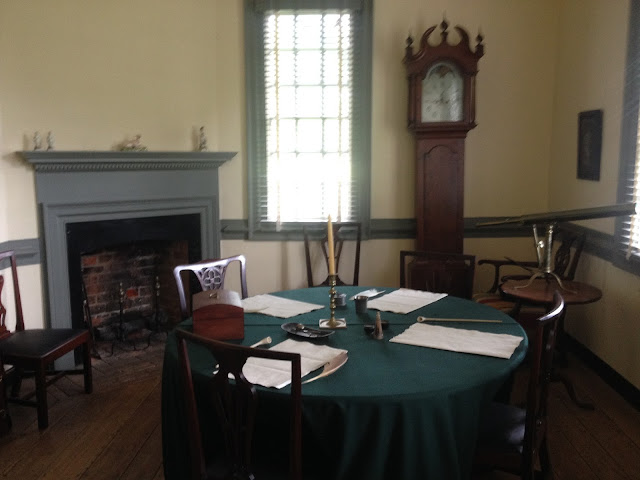We took a short drive this morning to visit the place where the seeds of the end of the British Empire in the Americas were sown. We got on the Colonial National Historic Parkway and drove east to the banks of the York River, which empties into Chesapeake Bay. The scenic road follows the river a bit south into Yorktown.
It also passes some of the US Navy's ship installations which dot the shoreline. The Navy has chosen this area for a significant amount of it's operations for the same reason that General, Lord Cornwallis did in 1881, the deep water channel.
Across the York River is the site of Powhatan's principal village. He was the native american chief that befriended the First Colony settlers.
We stopped at the Visitors Center and learned the details of the Siege of Yorktown. Our introduction started with the founding of Yorktown in 1691, and soon became a major trading center for Williamsburg and surrounding towns. By 1750, Yorktown had reached it's zenith, with a population of about 1,800. Tobacco, which had fueled the towns growth, had depleted the soil, and planters began to move west in search of good land. Much of the town was destroyed during the Siege, and it never fully recovered.
We didn't spend much time in the gift shop, choosing to go right to the driving tour of the battlefield. One item caught our interest as we left the building, however. This cannon was captured personally by General Lafayette during the storming of a Redoubt during the Siege. Lafayette personally identified the cannon by the dent left in its side by an allied cannonball.
Out on the Battlefield Tour, a seven mile route that covers the British Inner Defense Line, The Allied siege lines, the Moore House, and Surrender Field. The gravel road winds through some beautiful hardwood forests.
Donna spotted a small pond, and had to stop for a photo.
Then we noticed some pond residents sunning themselves on a log. At one time seven turtles were happily taking a nap!
The details of the Siege of Yorktown are well documented. General Cornwallis, a very proper and arrogant British aristocrat, was convinced that the Continental Army had no chance of overwhelming his fortified position in Yorktown. He also had the York River at his back, and expected British ships of the line to soon arrive from New York, providing a backdoor if needed. Suffice it to say that his plans were flawed.
Cornwallis had ordered the erection of two defense lines around the town, as well as a number of redoubts which provided extraordinary cover for his artillery. The British troops had time to fortify their defense lines with sharpened wooden stakes and deep trenches. After discussion with his advisors, General Washington decided to entrust General Lafayette with the operation that was to prove pivotal to winning the war. One of the first things General Lafayette did was to petition for the diversion of a French fleet from a destination in New York to the York River, where a fierce naval battle took place, resulting in British fleet withdrawal, and removing the back door that Cornwallis depended on. 17,000 allied soldiers marched on Yorktown on September 28, 1891, to face the force of 8,300 seasoned British troops led by General Cornwallis. Cornwallis immediately withdrew his troops from the first defense line, allowing the allied troops to dig siege lines so that artillery bombardment could begin on the second defense line. After capturing British redoubts 9 and 10 on October 14, a second siege line was dug, bringing Allied artillery to within point-blank range. Two days later, Cornwallis surrendered his army.
Negotiations for the surrender were held at the nearby Moore House after several days. General Cornwallis initially demanded that he be allowed to surrender "with honor", which was very important in that day and time. General Lafayette refused, saying that Cornwallis would only receive the same surrender terms that he had insisted upon for the defeated forces in Charleston previously.
The house was severely damaged during the Civil War, but has been restored with a loving hand. The restoration is period accurate with most of the furnishings having been owned by the Moore family and retrieved from a safe storage place. This is the room that the negotiations took place in.
As part of the formal surrender, British troops were to march from Yorktown to a field near the Moore House, where troops from the French forces lined one side of the road, and troops of the Continental Army the other. Designed to humiliate the defeated army, the maneuver apparently succeeded, because records note that angry British soldiers threw their weapons down in a great pile. This fence line marks the road the British marched on to surrender.
We took a leisurely drive through the sites of the American and French encampments, including the site where General Washington set up his command center.
Yorktown is a pleasant, quaint little town, with many references back to it's history.
We walked a bit along the Riverwalk, a collection of shops and restaurants along the York River.
We found the Riverwalk Restaurant (original, no?) under the shadow of the John P Coleman Memorial Bridge, which takes US 17 across the river to Cornwallis' planned escape route, Gloucester Point.
A nice lunch restored our energy and renewed our spirit.
Our last look at the York River included a sailing vessel, adding an authentic air to the afternoon.















No comments:
Post a Comment